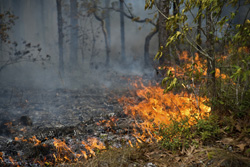Forest fire detection with flame-sensitive cameras
Forest fires are a large and worsening problem worldwide. Not only did they cause over 3 000 deaths in Europe in 2007 alone, they cost developed countries affected by them approximately 1 % of their gross domestic products (GDPs). Fires also cause about 20 % of total carbon dioxide (CO2) emissions. To address this, the EU funded the FORFIRE project. It united partners from 6 European countries and ran for 30 months to November 2011. Since firefighting success depends on response time, the project's goal was to develop an autonomous and reliable fire early-detection system. The resulting system is essentially a special camera. It scans patches of forest, searching for the electromagnetic wavelengths characteristic of flames (vacuum UV (VUV) at around 200 nanometres). This band is important because, while the Sun is a powerful source of these wavelenghts, all of this energy is absorbed by the Earth's atmosphere. Thus, levels detectable on the ground can only mean a fire and not any other source. Effectively, the VUV sensor can only detect fires and is blind to all other emissions. This helps greatly reduce false alarms. The ultrasensitive camera surveys a wide area, and when it detects a source of VUV it precisely calculates the position and alerts an operator. To further reduce the risk of false alarms, the project's camera superimposes a conventional visible-light picture over the VUV image, enabling confirmation by the operator. FORFIRE developed the design for a cost-effective prototype meeting these and other demanding technical specifications. First, the project selected the best materials for industrial manufacture of the sensor. The design and manufacture of the prototype advanced the state of the art in detector technology. The result was a sensor vastly more sensitive than any competitor product, with a 1 km effective range. FORFIRE also developed the necessary position-calculation algorithms and a special electronics readout system for the operator. Project partners estimated the potential market for the product as exceeding EUR 800 million per year. The technology is also applicable to industrial applications. Rapid fire detection means they can be more quickly extinguished, reducing their human and economic toll.







